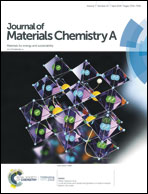Mo-doped Ni2P hollow nanostructures: highly efficient and durable bifunctional electrocatalysts for alkaline water splitting†
Abstract
The fabrication of an efficient bifunctional electrocatalyst towards alkaline overall water splitting is challenging, but in high demand. Herein, we report the construction of Mo-doped Ni2P hollow nanostructures through a solvothermal method and in situ phosphorization strategy. The Mo-doped Ni2P hollow nanostructures demonstrate excellent hydrogen evolution reaction (HER) activity in 1.0 M KOH solution with a low cathodic overpotential of 81 mV (10 mA cm−2, glassy carbon) and a small Tafel slope of 53.4 mV dec−1. First-principles density functional theory calculations reveal the mechanism of the alkaline HER. For pristine Ni2P, the P site serves as the active center. After Mo doping, the active center transforms to a bridging Mo–Ni site and the corresponding Gibbs free energy of H* absorption (ΔGH*) decreases from 0.33 eV (P site) to 0.21 eV (bridging Mo–Ni site). The optimal active site with a smaller ΔGH* can accelerate the charge transfer process for H* intermedium and H2 production. For the oxygen evolution reaction (OER), the Mo-doped Ni2P hollow nanostructures require 270 mV to attain 20 mA cm−2 (glassy carbon), with a small Tafel slope of 68.5 mV dec−1. Impressively, both the HER and OER catalysis exhibit durable performance in alkaline electrolyte. When the Mo-doped Ni2P hollow nanostructures are applied as bifunctional electrocatalysts for alkaline overall water splitting, the demanded cell voltage is only 1.54 V (10 mA cm−2, nickel foam).



 Please wait while we load your content...
Please wait while we load your content...